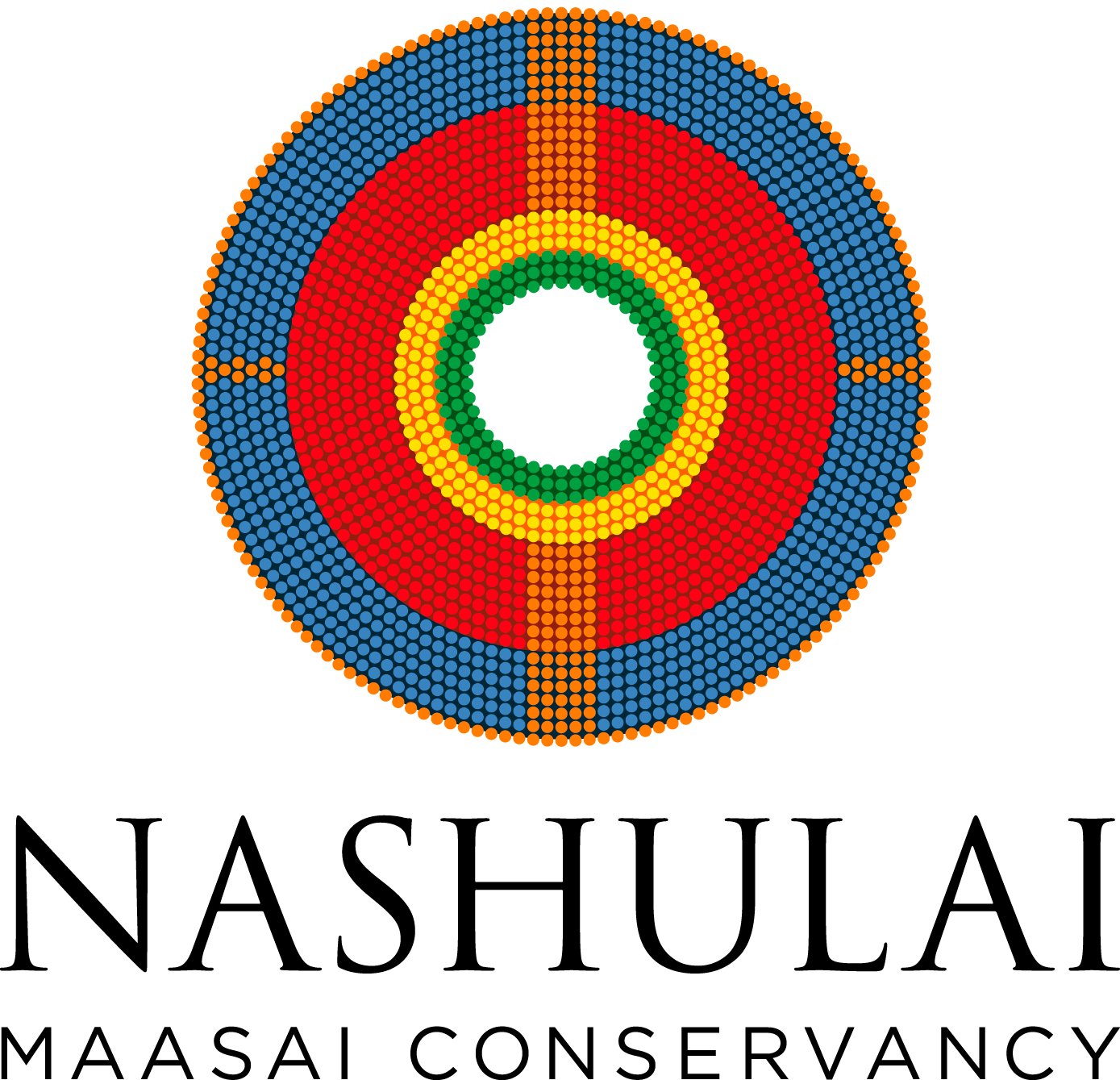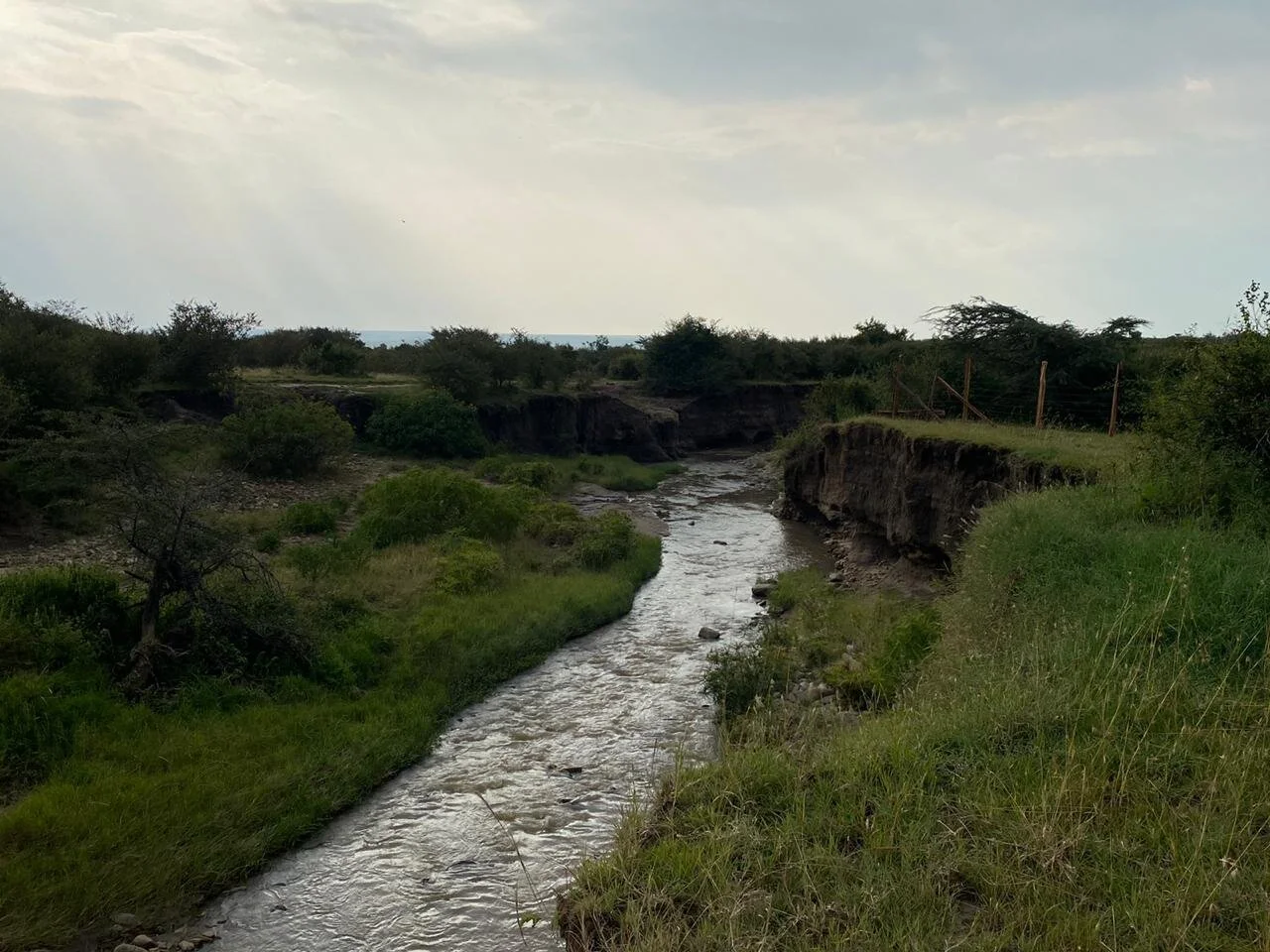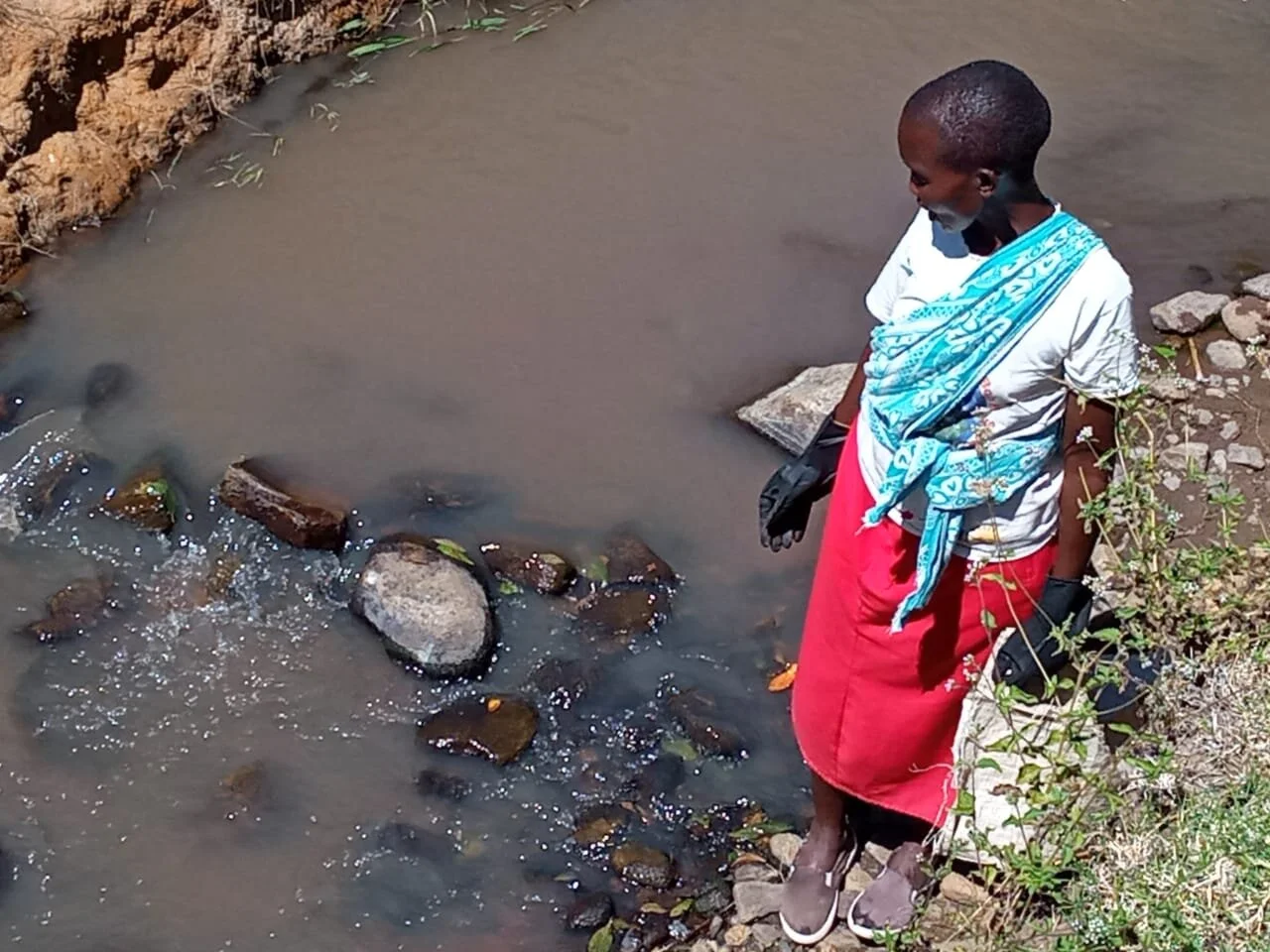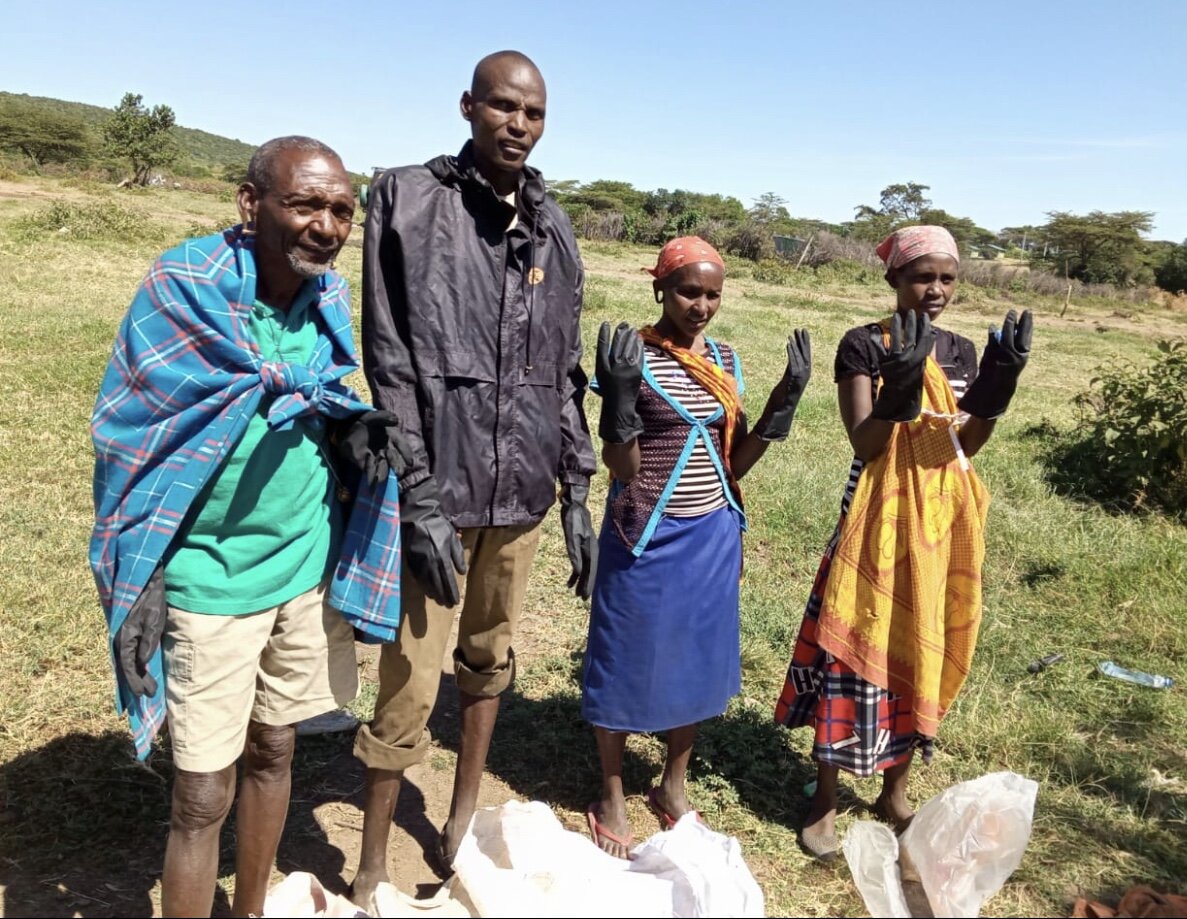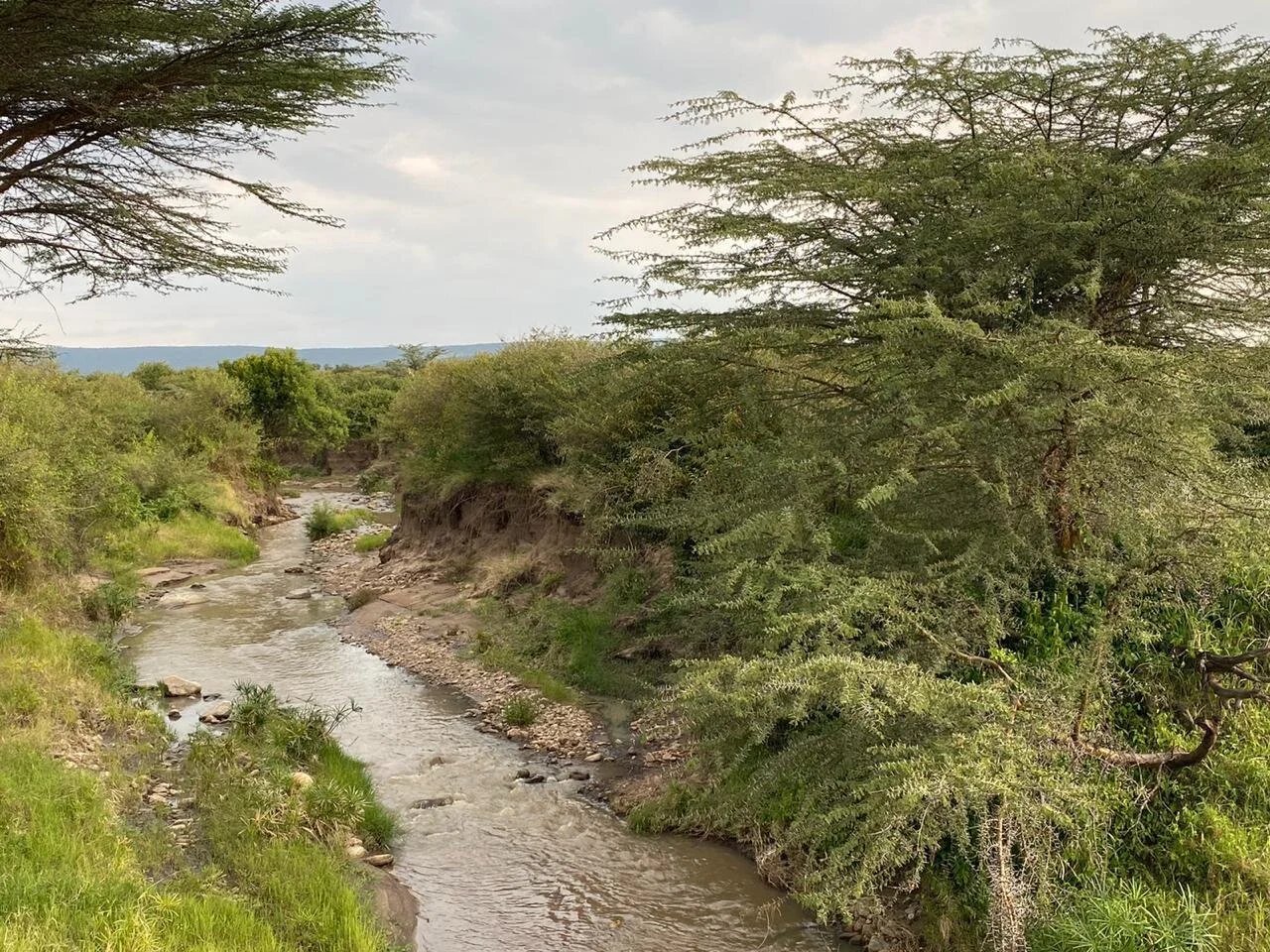Restoring the Mara’s Essential Lifeblood
On May 22, 2020 we began a community project, led by the women, to restore the Sekanani River to health. Even while battling the effects of Covid-19!
Humans, livestock, wild animals, birds—we all depend on water for survival. At Nashulai Maasai Conservancy our water comes from the Sekenani River, an 18 km-mountain stream, originating from the Leruk and Nkama Hills, that has run year-long since recorded times. The life blood of the area. Until now.
The Sekenani is under visible pressure from the dual threats of climate change and human overuse. Over the past decade, we’ve seen it with our own eyes: during the increasingly severe droughts the river dries up, then erodes its banks in the escalating flash floods; overgrazing, illegal sand harvesting and logging along the river causes further erosion and reduced water levels; at the same time, human waste—even from far upriver—is polluting the river, and increasing waterborne diseases (especially in our children). And our ancient sacred spaces located along the river are being lost to the erosion.
And it’s a threat not just within Nashulai, but far beyond our borders
The Sekenani River is a part of the great Mara River Basin supporting ecosystems and communities through Kenya and Tanzania. It flows into the Talek River which flows into the famous Mara River which feeds into Lake Victoria. It is a water source for the Maasai Mara National Reserve and also a source for the Serengeti National Park (a UNESCO World Heritage Site).
Last year the Mara River ran dry.
For the first time in memory, the great herds of wildebeest, zebra, and gazelles trekking from the Serengeti to the Northern Mara on their eons-old Great Migration could not swim the river. If the Mara River disappears (predicted to happen in the next 3-8 years unless IMMEDIATE MAJOR ACTION is taken) over 2 million animals will lose their main water source for their nearly 3,000km journey across the plains. We saw hippopotamus, crocodiles, and fish also displaced by their habitat drying up.
While this would have severe economic consequences to Kenya and Tanzania (from loss of tourism) and to the pastoralists and villagers, the loss to Earth’s biodiversity will be irreplaceable. And since the Mara River flows into Lake Victoria, the primary source of the increasingly water-stressed Nile, the ecological impacts will harm the nations and species living downstream. This isn’t theoretical: we’re daily made aware how fully interconnected is the health of our ecosystems.
That’s why we decided to take action NOW even while simultaneously fighting the impact of COVID-19.
We see it with our own eyes: we know THE WORLD CANNOT AFFORD TO WAIT.
Our river is beautiful but the damage from the lower water levels and the erosion of the banks is increasingly visible and unignorable.
30 years ago the Sekenani was crystal clear. Now its become brownish from decades of pollution.
We’re working together to improve the health of the Sekenani: we removed all waste along 13 km of the river and have just 5 km more to dredge!
One of several heaps of trash, some 30 years old, we’ve removed from the riverbed.
As featured on DW News
THE SEKENANI RIVER RESTORATION PROJECT
In the same spirit that the entire community in our small conservancy rallied on our own to combat food security near and far, and learn health measures in the Covid-19 crisis, we mobilized again, THANKS to a generous grant from our supporters at the Nordic firm Summa Equity which is focused on investing in sustainable approaches to global challenges.
Our immediate goal: At the end of Year 1, we plan to achieve a 90% reduction in non-biodegradable waste in the river; a 95% reduction in sand harvesting and a 99% reduction in illegal logging.
The People: Spearheaded by our Family, Gender and Education Group, the women of Nashulai Maasai Conservancy evolved the traditional Maasai role of women as the users of the river and keepers of traditional botanical knowledge into that of “River Protectors.”
As the traditional users of the water, we, the Women of Nashulai , are overseeing the restoration of this vital resource for the humans, wildlife, and livestock that depend on it!
Under the leadership of our director Maggie Koshal Reiyia, we, the women, are providing sanitation and sustainable river-use training at Sekenani village (the largest settlement). 120 women have been mobilized and employed (providing a small but much-needed income in the Covid-collapsed economy )in cleaning up non-biodegradable waste. We began by establishing an integrated approach to community support and participation. We involved the out-of-school youth of the community, joined by volunteers from communities throughout the Sekenani watershed, to assist us in shoring up the banks and tree planting. Our Nashulai scouts, as part of their human-wildlife conflict prevention are protecting our saplings from grazing wildlife and livestock and our river from illegal logging and sand harvesting.
Our holistic approach will have multiple benefits to both the ecosystem and communities throughout the region, achieving multiple interconnected United Nations Sustainable Development Goals. It vividly shows how community development and environmental protection work together for a bright, strong future.
Key Project Components
Reforesting our riverbank:
To prevent more erosion along the river, the first step is replanting trees along its banks. Thus far, 224 teens and youth have been recruited to plant 2,000 indigenous Pine, Jacaranda, Olive, Cypress, Croton and Croton Magnolia, Sandpaper Accodia and Fig saplings. They also ‘seed-bombed’ 25,000 Thornless Acacia and Yellow Acacia seedballs along the riverbank. 3,000 Bamboo seedlings have been planted in heavily eroded areas as a natural solution of erosion control. This overlaps with the Kenyan government’s commitment to increase tree cover 10% by 2020, and will simultaneously sequester carbon from the atmosphere, to help combat global warming. The Kenya Forest Service (KFS) upon seeing our work, donated 300 indigenous seedlings, and has partnered to provide more for our project’s next stage. Over the next 4 months we intend to double what we’ve planted.
Our community has come together to plant trees and native-grown bamboo along the river to prevent erosion and deforestation.
We’re really pleased that Nashulai youth (all out of school and college) are now completely committed to working hard to regenerate the once rich and beautiful land of their ancestors.
Taking advantage of the heavy rainfall this season we’ve planted 3000 bamboo seedlings along the riverbanks, spring sources and catchment areas. We plan to double that in 4 months.
We’re donating seeds and saplings to other Community Based Organizations throughout the watershed so they can partner with us to replant their own sections of the river. There is always more work to do, so please add your shoulder to our efforts too!
Eliminating logging and sand-harvesting along the river:
These illegal activities contribute to the erosion and flooding of the river but are mostly driven by poverty, so our efforts to increase local prosperity is the essential, long term solution. Our scouts—newly supported by our Warriors for Wildlife Protection volunteer youth group, will patrol those areas, and if necessary alert the authorities.
NEXT GOALS: Teaching citizen science to the next generation:
Through youth-focused education about water-monitoring technology, combined with traditional knowledge-sharing, we aim to provide our children with a chance to be involved in the Sekenani River’s stewardship, and gain a hands-on STEM education.
This educational component is now even more critically important due to COVID-19 school closures. We aim ultimately for 1,000 boys and girls to participate.
As girls traditionally aren’t encouraged to pursue the sciences, another key goal is inspiring and supporting our young water protectors to become the next generation of great female Maasai scientists and leaders.
When the Sekenani River has been cleaned of non-biodegradable and toxic waste, monitoring will be required to maintain its long-term stability.
Turning natural protection into business opportunities:
Our goal is to make our Sekenani River Restoration Project to be largely economically self-sustaining by end of Year 1. Here’s how we can restore the ecology and create new revenue streams simultaneously:
Building nurseries to grow our own saplings. Once our own planting is complete we aim to re-purpose the nurseries into a social enterprise supporting reforestation projects throughout Maasailand and beyond.
Establishing a beekeeping industry. Bees aren’t only fantastic natural protection (elephants love saplings, but who wants a bee up their trunk?), their pollination is integral to biodiversity. As this is a woman and youth-led project, the honey will be sold through Nashulai Women & Youth Co-Operatives.
Collaborating for maximum impact:
OUR DESIRE IS TO BE AN INNOVATION HUB: A key part of our project is ultimately to inspire, train, assist and help other communities across Maasailand to run their own river improvements and water-monitoring projects to help uplift the whole of the Mara River Basin.
700 people, primarily youth, were so moved by our Sekenani Restoration Project that they walked for miles from neighboring villages in a delegation of support, extending their hands to assist us!
Partnering:
Since the river affects the entire region we’ve now partnered with other local not-for-profit CBO organizations throughout the Sekenani watershed including: Sekenani Maasai Development Project (SEMADEP), Ewangan Maasai Cultural Village, and Olaimutiai Village, sharing seeds and saplings to help reforest their portions of the Sekenani River, while their communities provide and can benefit from the labour. Once our project was underway, the KFS partnered with us to provide 100s of additional saplings.
The Narok county government has now also expressed interest in our work. Once we have progressed further in our project, we aim to initiate at Nahsulai a river restoration training program for community leaders, in order to achieve maximum impact throughout the Mara River Basin. Long-term we hope to partner with other communities and conservancies to deepen and replicate our success across the watershed.
We’re taking inspiration and advice from a fellow indigenous people, the Heiltsuk of the northern Pacific West Coast of Canada, successful Qqs Projects Society’s youth-led Coastwatch community water management program.
But while we’re confident that our project will ultimately achieve our aim to save the Sekekani, it NEEDS to be scaled up to include other tributaries to save the Mara Watershed.
To help us achieve that, we call on our friends and supporters throughout the world to stand with us through your thoughtful donations and advocacy.
For project updates please follow us on social media
We would like to thank the supporters who donated their time to help us create this website
